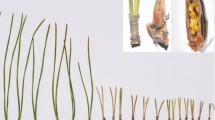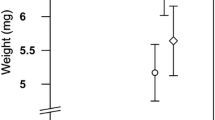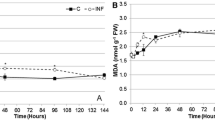Abstract
Main conclusion
Pinus sylvestris responds to insect egg deposition by ROS accumulation linked with reduced activity of the ROS scavenger catalase. Egg mortality in needles with hypersensitive response (HR)-like symptoms is enhanced.
Aggressive reactive oxygen species (ROS) play an important role in plant defence against biotic stressors, including herbivorous insects. Plants may even generate ROS in response to insect eggs, thus effectively fighting against future larval herbivory. However, so far nothing is known on how ROS-mediated plant defence against insect eggs is enzymatically regulated. Neither do we know how insects cope with egg-induced plant ROS. We addressed these gaps of knowledge by studying the activities of ROS-related enzymes in Pinus sylvestris deposited with eggs of the herbivorous sawfly Diprion pini. This species cuts a slit into pine needles and inserts its eggs into the needle tissue. About a quarter of egg-deposited needles show chlorotic tissue at the oviposition sites, indicating hypersensitive response-like direct defence responses resulting in reduced larval hatching from eggs. Hydrogen peroxide and peroxidase sensitive staining of sections of egg-deposited pine needles revealed the presence of hydrogen peroxide and peroxidase activity in needle tissue close to the eggs. Activity of ROS-producing NADPH-oxidase did not increase after egg deposition. However, the activity of the ROS-detoxifying enzyme catalase decreased after egg deposition and ovipositional wounding of needles. These results show that local ROS accumulation at the oviposition site is not caused by increased NADPH-oxidase activity, but reduced activity of pine needle catalase may contribute to it. However, our data suggest that pine sawflies can counteract the egg deposition-induced hydrogen peroxide accumulation in pine needles by high catalase activity in their oviduct secretion which is released with the eggs into pine tissue.




Similar content being viewed by others
Abbreviations
- APX:
-
Ascorbate peroxidase
- CAT:
-
Catalase
- HR:
-
Hypersensitive response
- ROS:
-
Reactive oxygen species
- SOD:
-
Superoxide dismutase
References
Almagro L, Gómez Ros LV, Belchi-Navarro S et al (2009) Class III peroxidases in plant defence reactions. J Exp Bot 60:377–390. doi:10.1093/jxb/ern277
Alscher RG, Erturk N, Heath LS (2002) Role of superoxide dismutases (SODs) in controlling oxidative stress in plants. J Exp Bot 53(1331–134):1. doi:10.1093/jexbot/53.372.1331
Angelini R, Tisi A, Rea G et al (2007) Involvement of polyamine oxidase in wound healing. Plant Physiol 146:162–177. doi:10.1104/pp.107.108902
Apel K, Hirt H (2004) Reactive oxygen species: metabolism, oxidative stress, and signal transduction. Annu Rev Plant Biol 55:373–399. doi:10.1146/annurev.arplant.55.031903.141701
Asada K (1992) Ascorbate peroxidase—a hydrogen peroxide-scavenging enzyme in plants. Physiol Plant 85:235–241. doi:10.1111/j.1399-3054.1992.tb04728.x
Barceló AR (1998) Hydrogen peroxide production is a general property of the lignifying xylem. Ann Bot 82:97–103. doi:10.1006/anbo.1998.0655
Barros J, Serk H, Granlund I, Pesquet E (2015) The cell biology of lignification in higher plants. Ann Bot 115:1053–1074. doi:10.1093/aob/mcv046
Baxter A, Mittler R, Suzuki N (2014) ROS as key players in plant stress signalling. J Exp Bot 65:1229–1240. doi:10.1093/jxb/ert375
Beyaert I, Köpke D, Stiller J et al (2012) Can insect egg deposition “warn” a plant of future feeding damage by herbivorous larvae? Proc R Soc B 279:101–108. doi:10.1098/rspb.2011.0468
Bi JL, Felton GW (1995) Foliar oxidative stress and insect herbivory: primary compounds, secondary metabolites, and reactive oxygen species as components of induced resistance. J Chem Ecol 21:1511–1530. doi:10.1007/BF02035149
Bombosch S, Ramakers PMJ (1976) Zur Dauerzucht von Gilpinia hercyniae Htg. Z Pflanzenk Pflanzen 83:40–44
Bozhkov PV, Lam E (2011) Green death: revealing programmed cell death in plants. Cell Death Differ 18:1239–1240. doi:10.1038/cdd.2011.86
Brauns A (1991) Taschenbuch der Waldinsekten, 4th edn. Gustav Fischer Verlag, Stuttgart
Caverzan A, Passaia G, Rosa SB et al (2012) Plant responses to stresses: role of ascorbate peroxidase in the antioxidant protection. Genet Mol Biol 35:1011–1019. doi:10.1590/S1415-47572012000600016
Chen MS (2008) Inducible direct plant defense against insect herbivores: a review. Insect Sci 15:101–114. doi:10.1111/j.1744-7917.2008.00190.x
Coll NS, Epple P, Dangl JL (2011) Programmed cell death in the plant immune system. Cell Death Differ 18:1247–1256. doi:10.1038/cdd.2011.37
da Carvalho KS, Pinheiro HA, Festucci-Buselli RA et al (2013) Diurnal changes in leaflet gas exchange, water status and antioxidant responses in Carapa guianensis plants under water-deficit conditions. Acta Physiol Plant 35:13–21. doi:10.1007/s11738-012-1043-6
DeJong RJ, Miller LM, Molina-Cruz A et al (2007) Reactive oxygen species detoxification by catalase is a major determinant of fecundity in the mosquito Anopheles gambiae. Proc Natl Acad Sci USA 104:2121–2126. doi:10.1073/pnas.0608407104
Diaz-Albiter H, Mitford R, Genta FA et al (2011) Reactive oxygen species scavenging by catalase is important for female Lutzomyia longipalpis fecundity and mortality. PLoS One 6:e17486. doi:10.1371/journal.pone.0017486
Durner J, Klessig DF (1995) Inhibition of ascorbate peroxidase by salicylic acid and 2,6-dichloroisonicotinic acid, two inducers of plant defense responses. Proc Natl Acad Sci USA 92:11312–11316. doi:10.1073/pnas.92.24.11312
Durner J, Klessig DF (1996) Salicylic acid is a modulator of tobacco and mammalian catalases. J Biol Chem 271:28492–28501. doi:10.1074/jbc.271.45.28492
Eichhorn O (1976) Dauerzucht von Diprion pini L. (Hym.: Diprionidae) im Laboratorium unter Berücksichtigung der Fotoperiode. Anz Schädlingskd Pfl 49:38–41. doi:10.1007/BF02342165
Fatouros NE, Lucas-Barbosa D, Weldegergis BT et al (2012) Plant volatiles induced by herbivore egg deposition affect insects of different trophic levels. PLoS One 7:e43607. doi:10.1371/journal.pone.0043607
Fatouros NE, Paniagua Voirol LR, Drizou F et al (2015) Role of large cabbage white butterfly male-derived compounds in elicitation of direct and indirect egg-killing defenses in the black mustard. Front Plant Sci 6:1–9. doi:10.3389/fpls.2015.00794
Felton GW, Summers CB (1995) Antioxidant systems in insects. Arch Insect Biochem Physiol 29:187–197. doi:10.1002/arch.940290208
Gershenzon J, Croteau R (1991) Terpenoids. In: Rosenthal GA, Berenbaum MR (eds) Herbivores: their interactions with secondary plant metabolites, 2nd edn. Academic Press, San Diego, pp 165–219
Gillespie KM, Rogers A, Ainsworth EA (2011) Growth at elevated ozone or elevated carbon dioxide concentration alters antioxidant capacity and response to acute oxidative stress in soybean (Glycine max). J Exp Bot 62:2667–2678. doi:10.1093/jxb/erq435
Glatz R, Schmidt O, Asgari S (2004) Isolation and characterization of a Cotesia rubecula bracovirus gene expressed in the lepidopteran Pieris rapae. J Gen Virol 85:2873–2882. doi:10.1099/vir.0.80307-0
Gouhier-Darimont C, Schmiesing A, Bonnet C et al (2013) Signalling of Arabidopsis thaliana response to Pieris brassicae eggs shares similarities with PAMP-triggered immunity. J Exp Bot 64:665–674. doi:10.1093/jxb/ers362
Gupta K, Sengupta A, Chakraborty M, Gupta B (2016) Hydrogen peroxide and polyamines act as double edged swords in plant abiotic stress responses. Front Plant Sci 7:1–19. doi:10.3389/fpls.2016.01343
Hao Z-P, Zhao J-R, Yuan Z-Q et al (2012) Influence of photoperiod on hydrogen peroxide metabolism during diapause induction in Cotesia vestalis (Haliday) (Hymenoptera: Braconidae). J Kansas Entomol Soc 85:206–218. doi:10.2317/JKES120318.1
Hilker M, Fatouros NE (2015) Plant responses to insect egg deposition. Annu Rev Entomol 60:493–515. doi:10.1146/annurev-ento-010814-020620
Hilker M, Fatouros NE (2016) Resisting the onset of herbivore attack: plants perceive and respond to insect eggs. Curr Opin Plant Biol 32:9–16. doi:10.1016/j.pbi.2016.05.003
Hilker M, Kobs C, Varama M, Schrank K (2002a) Insect egg deposition induces Pinus sylvestris to attract egg parasitoids. J Exp Biol 205:455–461
Hilker M, Rohfritsch O, Meiners T (2002b) The plant’s response towards insect egg deposition. In: Hilker M, Meiners T (eds) Chemoecology of insect eggs and egg deposition. Blackwell Publishing Ltd, Oxford, pp 205–233
Hilker M, Stein C, Schröder R et al (2005) Insect egg deposition induces defence responses in Pinus sylvestris: characterisation of the elicitor. J Exp Biol 208:1849–1854. doi:10.1242/jeb.01578
Jiménez-Bremont JF, Marina M, de la Guerrero-González ML et al (2014) Physiological and molecular implications of plant polyamine metabolism during biotic interactions. Front Plant Sci 5:95. doi:10.3389/fpls.2014.00095
Johansson LH, Borg LA (1988) A spectrophotometric method for determination of catalase activity in small tissue samples. Anal Biochem 174:331–336
Köpke D, Schröder R, Fischer HM et al (2008) Does egg deposition by herbivorous pine sawflies affect transcription of sesquiterpene synthases in pine? Planta 228:427–438. doi:10.1007/s00425-008-0747-8
Köpke D, Beyaert I, Gershenzon J et al (2010) Species-specific responses of pine sesquiterpene synthases to sawfly oviposition. Phytochemistry 71:909–917. doi:10.1016/j.phytochem.2010.03.017
Lai AG, Doherty CJ, Mueller-Roeber B et al (2012) CIRCADIAN CLOCK-ASSOCIATED 1 regulates ROS homeostasis and oxidative stress responses. Proc Natl Acad Sci USA 109:17129–17134. doi:10.1073/pnas.1209148109
Lamb C, Dixon RA (1997) The oxidative burst in plant disease resistance. Annu Rev Plant Physiol Plant Mol Biol 48:251–275. doi:10.1146/annurev.arplant.48.1.251
Lane BG (2002) Oxalate, germins, and higher-plant pathogens. IUBMB Life 53:67–75. doi:10.1080/10399710290038954
Little D, Gouhier-Darimont C, Bruessow F, Reymond P (2007) Oviposition by pierid butterflies triggers defense responses in Arabidopsis. Plant Physiol 143:784–800. doi:10.1104/pp.106.090837
Liu X, Williams CE, Nemacheck JA et al (2010) Reactive oxygen species are involved in plant defense against a gall midge. Plant Physiol 152:985–999. doi:10.1104/pp.109.150656
Lyytikäinen-Saarenmaa P, Lyytikäinen-Saarenmaa P, Tomppo E (2002) Impact of sawfly defoliation on growth of Scots pine Pinus sylvestris (Pinaceae) and associated economic losses. Bull Entomol Res 92:137–140. doi:10.1079/BER2002154
Mathews MC, Summers CB, Felton GW (1997) Ascorbate peroxidase: a novel antioxidant enzyme in insects. Arch Insect Biochem Physiol 34:57–68. doi:10.1002/(SICI)1520-6327(1997)34:1<57:AID-ARCH5>3.0.CO;2-T
Meng X, Zhang S (2013) MAPK cascades in plant disease resistance signaling. Annu Rev Phytopathol 51:245–266. doi:10.1146/annurev-phyto-082712-102314
Minibayeva F, Beckett RP, Kranner I (2015) Roles of apoplastic peroxidases in plant response to wounding. Phytochemistry 112:122–129. doi:10.1016/j.phytochem.2014.06.008
Mittler R (2002) Oxidative stress, antioxidants and stress tolerance. Trends Plant Sci 7:405–410. doi:10.1016/B978-044482650-3/50031-6
Mittler R, Vanderauwera S, Gollery M, Van Breusegem F (2004) Reactive oxygen gene network of plants. Trends Plant Sci 9:490–498. doi:10.1016/j.tplants.2004.08.009
Mittler R, Vanderauwera S, Suzuki N et al (2011) ROS signaling: the new wave? Trends Plant Sci 16:300–309. doi:10.1016/j.tplants.2011.03.007
Morel JB, Dangl JL (1997) The hypersensitive response and the induction of cell death in plants. Cell Death Differ 4:671–683. doi:10.1038/sj.cdd.4400309
Mumm R, Hilker M (2006) Direct and indirect chemical defence of pine against folivorous insects. Trends Plant Sci 11:351–358. doi:10.1016/j.tplants.2006.05.007
Mumm R, Schrank K, Wegener R et al (2003) Chemical analysis of volatiles emitted by Pinus svlvestris after induction by insect oviposition. J Chem Ecol 29:1235–1252. doi:10.1023/A:1023841909199
Mur LA, Kenton P, Lloyd AJ et al (2008) The hypersensitive response; the centenary is upon us but how much do we know? J Exp Bot 59:501–520. doi:10.1093/jxb/erm239
Murias M, Rachtan M, Jodynis-Liebert J (2005) Effect of multiple freeze-thaw cycles of cytoplasm samples on the activity of antioxidant enzymes. J Pharmacol Toxicol Methods 52:302–305. doi:10.1016/j.vascn.2005.03.002
Navrot N, Rouhier N, Gelhaye E, Jacquot JP (2007) Reactive oxygen species generation and antioxidant systems in plant mitochondria. Physiol Plant 129:185–195. doi:10.1111/j.1399-3054.2006.00777.x
Noctor G, Mhamdi A, Foyer CH (2016) Oxidative stress and antioxidative systems: recipes for successful data collection and interpretation. Plant, Cell Environ 39:1140–1160. doi:10.1111/pce.12726
O’Brien JA, Daudi A, Butt VS, Bolwell GP (2012) Reactive oxygen species and their role in plant defence and cell wall metabolism. Planta 236:765–779. doi:10.1007/s00425-012-1696-9
O’Reilly JE, dos Reis M, Donoghue PCJ (2015) Dating tips for divergence-time estimation. Trends Genet 31:637–650. doi:10.1016/j.tig.2015.08.001
Oliveira DC, Isaias RMS, Fernandes GW et al (2016) Manipulation of host plant cells and tissues by gall-inducing insects and adaptive strategies used by different feeding guilds. J Insect Physiol 84:103–113. doi:10.1016/j.jinsphys.2015.11.012
Olson PD, Varner JE (1993) Hydrogen peroxide and lignification. Plant J 4:887–892. doi:10.1046/j.1365-313X.1993.04050887.x
Passardi F, Cosio C, Penel C, Dunand C (2005) Peroxidases have more functions than a swiss army knife. Plant Cell Rep 24:255–265. doi:10.1007/s00299-005-0972-6
Popović M, Šuštar V, Gričar J et al (2016) Identification of environmental stress biomarkers in seedlings of European beech (Fagus sylvatica) and Scots pine (Pinus sylvestris). Can J For Res 46:58–66. doi:10.1139/cjfr-2015-0274
R Development Core Team (2015) R: A language and environment for statistical computing
Reape TJ, Molony EM, McCabe PF (2008) Programmed cell death in plants: distinguishing between different modes. J Exp Bot 59:435–444. doi:10.1093/jxb/erm258
Reczek CR, Chandel NS (2015) ROS-dependent signal transduction. Curr Opin Cell Biol 33:8–13. doi:10.1016/j.ceb.2014.09.010
Reymond P (2013) Perception, signaling and molecular basis of oviposition-mediated plant responses. Planta 238:247–258. doi:10.1007/s00425-013-1908-y
Roach T, Colville L, Beckett RP et al (2015) A proposed interplay between peroxidase, amine oxidase and lipoxygenase in the wounding-induced oxidative burst in Pisum sativum seedlings. Phytochemistry 112:130–138. doi:10.1016/j.phytochem.2014.06.003
Rojas CM, Senthil-Kumar M, Wang K et al (2012) Glycolate oxidase modulates reactive oxygen species-mediated signal transduction during nonhost resistance in Nicotiana benthamiana and Arabidopsis. Plant Cell 24:336–352. doi:10.1105/tpc.111.093245
Ros-Barceló A, Pomar F, López-Serrano M et al (2002) Developmental regulation of the H2O2-producing system and of a basic peroxidase isoenzyme in the Zinnia elegans lignifying xylem. Plant Physiol Biochem 40:325–332. doi:10.1016/S0981-9428(02)01376-1
Sim C, Denlinger DL (2011) Catalase and superoxide dismutase-2 enhance survival and protect ovaries during overwintering diapause in the mosquito Culex pipiens. J Insect Physiol 57:628–634. doi:10.1016/j.jinsphys.2011.01.012
Smith PK, Krohn RI, Hermanson GT et al (1985) Measurement of protein using bicinchoninic acid. Anal Biochem 150:76–85. doi:10.1016/0003-2697(85)90442-7
Torres MA (2010) ROS in biotic interactions. Physiol Plant 138:414–429. doi:10.1111/j.1399-3054.2009.01326.x
Wu J, Baldwin IT (2010) New insights into plant responses to the attack from insect herbivores. Annu Rev Genet 44:1–24. doi:10.1146/annurev-genet-102209-163500
Acknowledgements
We thank the technicians Ute Braun and Gabriele Haberberger, Institute of Biology, Freie Universität Berlin, for rearing and maintaining the sawfly population, and the students Juliane Dankwarth and Marlena Winter for dissecting sawflies and supporting the enzymatic assays. We also thank Prof. Dr. Christian Schmitz-Linneweber and Arne Hillebrand, Humboldt Universität Berlin, for technical support with ultracentrifugation and Prof. Dr. Margarete Baier, Freie Universität Berlin, for her advice in enzyme activity analysis. Furthermore, we thank two anonymous reviewers for their helpful comments.
Author information
Authors and Affiliations
Corresponding author
Ethics declarations
All animals in this study were treated according to legal guidelines of the European Union and the Federal Republic of Germany as well as according to institutional guidelines of Freie Universität Berlin.
Conflict of interest
The authors declare they have no conflict of interest and consented in submitting and publishing this study.
Funding
This study was funded by the German Research Foundation (DFG Hi 416/22-1).
Rights and permissions
About this article
Cite this article
Bittner, N., Trauer-Kizilelma, U. & Hilker, M. Early plant defence against insect attack: involvement of reactive oxygen species in plant responses to insect egg deposition. Planta 245, 993–1007 (2017). https://doi.org/10.1007/s00425-017-2654-3
Received:
Accepted:
Published:
Issue Date:
DOI: https://doi.org/10.1007/s00425-017-2654-3




